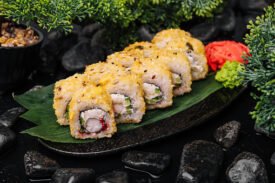Panko is a type of breadcrumb that originated in Japan. Unlike regular breadcrumbs, panko is made from bread without crusts, resulting in a lighter, crunchier texture. Panko is commonly used in Japanese cuisine, but it has become popular in Western cuisine as well, particularly in dishes like fried chicken, fish, and vegetables.
Is Panko Vegan?
The short answer is yes; panko is generally considered vegan. Panko is made from flour, yeast, salt, and water, which are all vegan-friendly ingredients. However, there are a few things to keep in mind.
Check for Animal Ingredients
While the base ingredients of panko are vegan-friendly, some brands may include non-vegan additives like eggs or dairy. Always check the label before purchasing panko to ensure that it does not contain any animal products.
Cross-Contamination
Another thing to consider is cross-contamination. Some panko manufacturers may process their breadcrumbs on equipment that also processes non-vegan products, like eggs or dairy. If cross-contamination is a concern for you, look for brands that explicitly state that their panko is vegan and produced in a dedicated facility.
Vegan Panko Alternatives
If you’re unable to find vegan-friendly panko, there are plenty of alternatives available. Here are a few options:
Homemade Breadcrumbs
You can easily make your own breadcrumbs by toasting bread and then grinding it in a food processor. This option allows you to control the ingredients and ensure that they are vegan.
Corn Flakes
Crushed corn flakes can be a great substitute for panko. They have a similar texture and can be used in the same dishes.
Crushed Nuts
Crushed nuts, like almonds or cashews, can add a crunchy texture to dishes and make a great vegan substitute for panko.
How to Use Panko in Vegan Dishes
Panko can be used in a variety of vegan dishes, including:
· Tofu Nuggets
Coat tofu nuggets in panko and bake or fry for a delicious vegan alternative to chicken nuggets.
· Vegetable Tempura
Panko is commonly used in Japanese vegetable tempura. Dip your favorite veggies in batter and coat in panko before frying.
· Vegan Crab Cakes
Use panko to coat vegan crab cakes for a crispy, crunchy texture.
Benefits of Using Panko in Vegan Cooking
Panko can provide numerous benefits in vegan cooking beyond its delicious crunch. Panko can absorb less oil than regular breadcrumbs, resulting in a healthier, less greasy dish. Additionally, panko can help create a light and airy texture that works well with a variety of dishes, from savory to sweet.
How to Store Panko
To keep your panko fresh, store it in an airtight container in a cool, dry place. This will help prevent moisture from causing the breadcrumbs to clump together. Panko can last up to six months when stored properly.
Panko in Desserts
While panko is most commonly used in savory dishes, it can also be used in desserts. Panko can be used as a crispy topping for fruit crisps and crumbles, or as a crunchy coating for fried desserts like donuts or funnel cakes.
Making Panko Stick to Food
To make panko stick to food, it’s important to properly coat the food before adding the breadcrumbs. First, dip the food in a liquid like egg or milk, then coat it in flour. This will help create a sticky surface for the panko to adhere to. Once coated in panko, the food can be fried or baked.
Panko vs. Regular Breadcrumbs
While panko and regular breadcrumbs may seem similar, they can have different textures and uses in cooking. Panko tends to be lighter and crunchier than regular breadcrumbs, making it ideal for crispy coatings. Regular breadcrumbs are finer and denser, and may work better in recipes that require a finer texture. Ultimately, the choice between panko and regular breadcrumbs will depend on the specific recipe and desired outcome.
Panko in Japanese Cuisine
Panko is a staple ingredient in Japanese cuisine and is commonly used to create crunchy coatings for dishes like tonkatsu (breaded and fried pork cutlets) and katsu curry (Japanese-style curry with breaded and fried meat). Panko is also used in a variety of Japanese snack foods, like takoyaki (octopus’s balls) and korokke (croquettes).
Making Vegan Panko at Home
While there are many brands of vegan-friendly panko available in stores, it’s also possible to make your own vegan panko at home. Simply take a few slices of bread and remove the crusts. Cut the bread into small cubes and pulse them in a food processor until they become small, uniform breadcrumbs. Spread the breadcrumbs on a baking sheet and bake in the oven at 300°F for 8-10 minutes, or until they become light golden brown.
Panko in Gluten-Free Cooking
For those following a gluten-free diet, panko can still be a great ingredient to use in cooking. While traditional panko is made from wheat flour, there are several gluten-free panko options available, like Ian’s Natural Foods Gluten Free Panko Breadcrumbs. Alternatively, it’s also possible to make your own gluten-free panko using gluten-free bread. Simply follow the same process as making traditional panko, but with gluten-free bread instead.
Panko Brands
There are several brands of panko available in the market, including Kikkoman, Ian’s, and Authentic Japanese Panko. It’s important to note that not all panko brands are vegan, as some may contain animal-derived ingredients like honey or eggs. Always check the ingredients list before purchasing to ensure that the panko is vegan-friendly.
Conclusion
In conclusion, panko can be a great ingredient to use in vegan cooking. It can provide a delicious, crunchy texture to a variety of dishes while being vegan-friendly. It’s important to keep in mind that not all panko is created equal, so always check the ingredients list to ensure that the panko is vegan. With its versatility and ease of use, panko is a great addition to any vegan kitchen.

